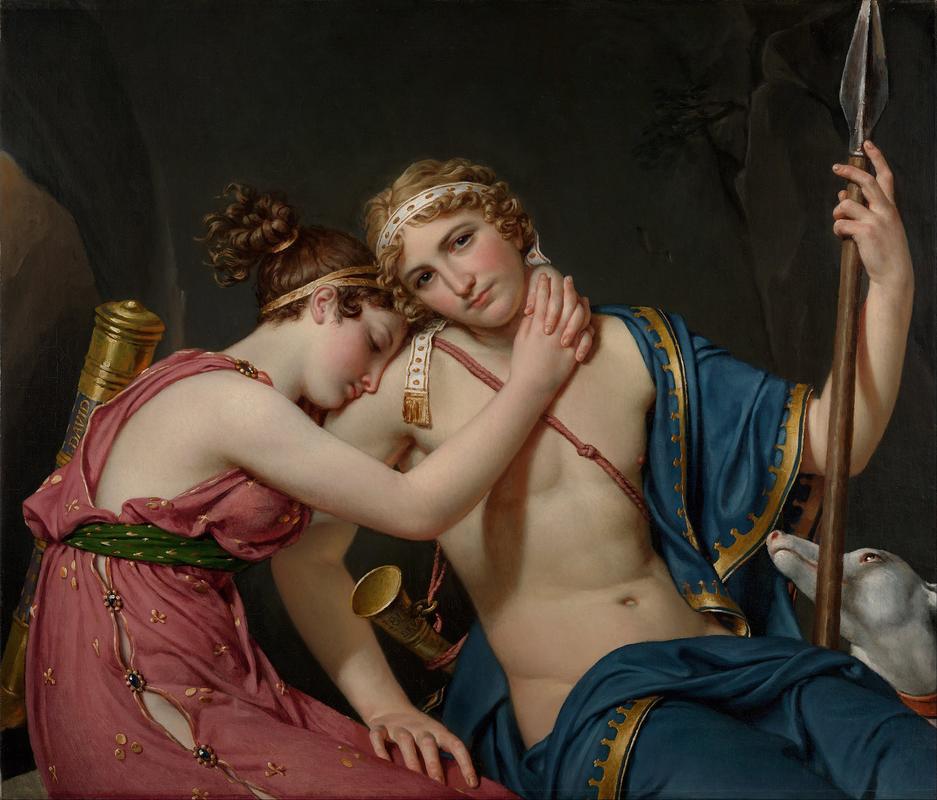More about The Farewell of Telemachus and Eucharis

Contributor
The Farewell of Telemachus and Eucharis is a painting about a boy who went looking for his dad but fell hard for a girl instead.
This is a tale of young love which ensnared the elderly Jacques-Louis David. David captures the tenderness of the two lovers, but also the realization that this beautiful thing won’t last, can’t last, because Telemachus’ has got to go and save his papa, Odysseus.
It’s a struggle for the young prince. The painting takes place in a cave on Calypso Island, where Telemachus falls for the nymph Eucharis. The two lovers are hiding out in a cave, taking refuge from Calypso’s jealousy. This is one tricky woman, because Calypso also took Odysseus as prisoner on her island. The pressure’s on Telemachus, who probably just needed a break from his task. Thankfully, Telemachus resumes the journey of finding Odysseus, but only after he’s pushed off a cliff and into the ocean so he can get over the renowned beauty that was Eucharis. Honestly, they’re just a couple of kids in love, can’t somebody give them a break?
This painting was commissioned by Count Franz-Erwin von Schoenborn, who had the oo-la-la title of Vice President of the States-General of Bavaria. Von Schoenborn offered David 5,000 francs for the piece. David may have chosen the subject matter from the 1699 novel "The Adventures of Telemachus" by Fenelon, which was an interpretation of Homer’s "Odyssey." Eucharis does not appear in "Odyssey," so it’s believed Fenelon’s version was the main inspiration.
David was, at the time, in voluntary exile from France, and chose Brussels as his second home. Things were working out for him in Brussels. The Farewell of Telemachus and Eucharis was beloved by the people of Brussels and Ghent and the previous year David exhibited Cupid and Psyche in his adopted city and was in great spirits. The Farewell of Telemachus and Eucharis acted as a pendant to that painting, meaning the artist considered them a pair.
The Farewell of Telemachus and Eucharis was exhibited in Brussels for the benefit of the poor. David and his patron Schoenborn both seemed to have a big heart when it came to charity. There are even letters that show David permitted the government, upon their request, to extend the exhibition of the artwork. Their hope was to generate more profit with this extension to benefit the poor. By the end of the painting’s run, the revenue made from tickets was almost that of the sum originally paid for it.
Sources
- Allen, Denise, Masterpieces of Painting in the J. Paul Getty Museum. Los Angeles, Getty Publications, 2003.
- Johnson, Dorothy, Jacques-Louis David: The Farewell of Telemachus and Eucharis. Malibu: J. Paul Getty Museum, 1997.
- Moore, Fabienne, Prose Poems of the French Enlightenment: Delimiting Genre. Surry: Ashgate Publishing Limited, 2009.
Featured Content
Here is what Wikipedia says about The Farewell of Telemachus and Eucharis
The Farewell of Telemachus and Eucharis is a painting from 1818 by Jacques-Louis David, now in the J. Paul Getty Museum in Los Angeles, California. Painted during David's exile in Brussels, it was purchased by the Count von Schönborn-Wiesentheid. It depicts Telemachus and Eucharis, two characters in François Fénelon's 1699 novel Les Aventures de Télémaque, inspired by Homer's Odyssey. The artist's last painting of a couple from mythology, it is a pendant painting to his Love and Psyche.
Check out the full Wikipedia article about The Farewell of Telemachus and Eucharis













I like this piece Jacques-Louis David. The story of Telemachus is a sad tale, which is beautifully represented in this picture. Telemachus is looking at the viewer with sad eyes, knowing that his time of bliss is coming to an end. This painting is a great example of the neoclassical period by telling the ancient tale of these two lovers. Along with the retelling of this tale, the smooth lines, distribution of light, and clear defined forms are also what stands out from this neoclassical piece.